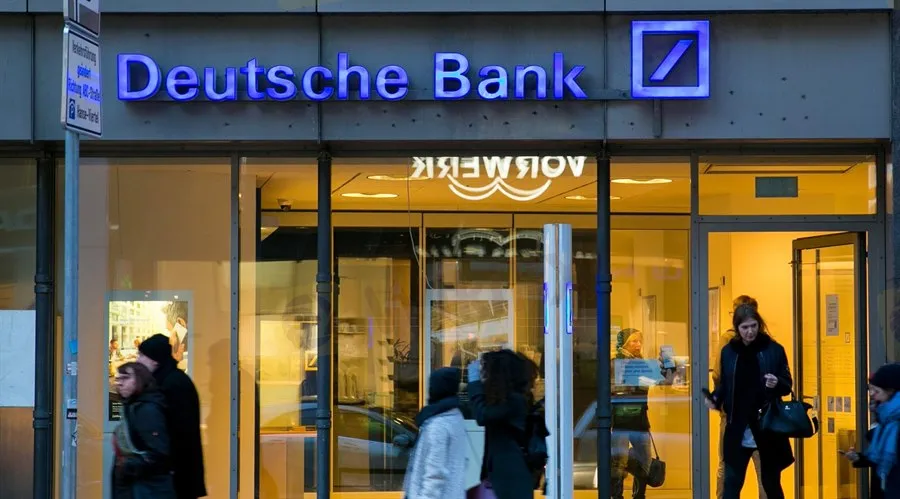简体中文
繁體中文
English
Pусский
日本語
ภาษาไทย
Tiếng Việt
Bahasa Indonesia
Español
हिन्दी
Filippiiniläinen
Français
Deutsch
Português
Türkçe
한국어
العربية
Deutsche Bank Recognizes It Has a ‘Very Limited’ Russia Exposure
Abstract:Deutsche Bank, Germany-based financial services giant, has disclosed more details about its risk exposures to Russia and Ukraine on Wednesday. Basically, the financial services firm stated that it had reduced its Russian exposure and local footprint ‘significantly’ since 2014, with further reductions amid the crisis in the past two weeks.

The bank had a 'modest defensive position' during Russia's invasion of Ukraine.
Net loan exposure to Ukraine was EUR 42 million as of December 31, 2021.
“Our direct exposures are currently very limited and tightly managed. Second- and third-order effects of the current situation, including sanctions and cybersecurity risk, are being carefully evaluated and monitored,” Stuart Lewis, Chief Risk Officer and Member of the Management Board at Deutsche Bank, commented.
The bank‘s exposure to Russia and Ukraine represents a very small percentage of its overall loan portfolio and is protected by several risk mitigation measures. While market risk exposures have been significantly reduced prior to and following Russia’s invasion of Ukraine, these measures include offshore collateral and financial guarantees.
For example, as of December 31, 2021, the net loan exposure to Russia was EUR 0.6 billion after taking account of guarantees and asset collateral. Also, net loan exposure to Ukraine was EUR 42 million at that time, which is EUR 0.6 billion gross.
In addition, Deutsche Bank clarified that the wealth management businesss offshore loans to counterparties with a Russian connection were adequately collateralized, and the collateral is not tied to Russia.
Germany-based financial services giant also clarified that its Russia/Ukraine market risk exposure was ‘well contained’ and the bank had a ‘modest defensive position.’
Deutsche Bank 2021 Net Profits
Deutsche Bank reported a significant jump in its net profit as the number surpassed EUR 2.5 billion in 2021, which is the highest level since 2011.
In terms of profit before tax, the bank reported a figure of EUR 3.4 billion in the last year. Deutsche Bank witnessed strong growth across all of its four core businesses. In Q4 of 2021, the bank posted a net profit of EUR 315 million, which is up 67% compared to the same period last year.

Disclaimer:
The views in this article only represent the author's personal views, and do not constitute investment advice on this platform. This platform does not guarantee the accuracy, completeness and timeliness of the information in the article, and will not be liable for any loss caused by the use of or reliance on the information in the article.
Read more

Blockchain Decentralization: Empowering a Trustless Future
In recent years, blockchain technology has rapidly evolved from a niche innovation behind Bitcoin into a transformative force across industries. At its core, blockchain decentralization refers to the distribution of authority and decision-making away from a central entity and into the hands of a distributed network of participants. This shift redefines how data is stored and verified and paves the way for trustless, transparent, and resilient systems that challenge traditional centralized models.

The president of @Liberland, @Vít Jedlička come on stage, dialogue on trading security.
The 2025 WikiEXPO Hong Kong Station is about to grandly open. the president of @Liberland, @Vít Jedlička come on stage, dialogue on trading security.

Countdown: 1 day.WikiEXPO2025's first stop, Hong Kong, is about to open.
⏰ Countdown: 1 day. WikiEXPO2025's first stop, Hong Kong, is just tomorrow. Focus on transaction security and explore new investment opportunities. ???? Get ready to start now. See you tomorrow.

JustForex vs JustMarkets: A Comprehensive Comparison in 2025
Selecting the right forex broker can make the difference between trading success and frustration for most investors, especially retail investors. As retail traders gain unprecedented access to global markets, the choice between platforms like JustForex and JustMarkets becomes increasingly significant. Both brokers offer some shining features within the forex and CFD trading space, but their approaches differ in some areas.
WikiFX Broker
Latest News
The Withdrawal Trap: How Scam Brokers Lure Victims into Paying More
FCA to Investors: Think Twice Before Trusting These Brokers
Trump\s tariffs: How could they affect the UK and your money
Trump gambles it all on global tariffs he\s wanted for decades
TradingView Brings Live Market Charts to Telegram Users with New Mini App
Trump tariffs: How will India navigate a world on the brink of a trade war?
Interactive Brokers Launches Forecast Contracts in Canada for Market Predictions
Authorities Alert: MAS Impersonation Scam Hits Singapore
Stocks fall again as Trump tariff jitters continue
IG Group Acquires Freetrade for £160M to Expand UK Investment Market
Currency Calculator







